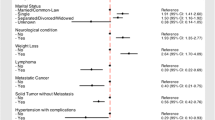Abstract
Background
Crohn’s disease (CD) is a chronically relapsing condition that frequently requires hospitalization. In 2008, the Centers for Medicare and Medicaid Services selected ten conditions that were deemed healthcare-acquired conditions (HACs). Costs related to HACs are not reimbursed as they are considered to be preventable.
Aim
To determine the prevalence and impact of HACs on hospital outcomes of hospitalized CD patients.
Methods
This was a cross-sectional study using data from the Nationwide Inpatient Sample between 2007 and 2011 with an extended time frame between 2002 and 2013 to specifically evaluate the prevalence of HACs. CD-related hospitalizations and HACs were identified using International Classification of Diseases, Ninth revision, Clinical modification codes. The trend of HACs between 2002 and 2013 was assessed using a Cochran–Armitage test. Primary outcomes, including hospital mortality, length of stay, and hospital charges, were analyzed using univariate and multivariate analyses.
Results
The prevalence of HACs initially increased between 2002 and 2008, remained stable between 2008 and 2011, than significantly decreased from 2011 to 2013. CD patients with HACs had higher hospital mortality, prolonged LOS, and higher hospital charges compared to patients without HACs.
Conclusions
The prevalence of HACs among hospitalized CD patients initially increased from 2002 to 2008; however, rates began to decrease between 2011 and 2013. In addition, HACs were associated with worse healthcare outcomes in hospitalized CD patients.

Similar content being viewed by others
References
Kohn LT, Corrigan J, Donaldson MS. To Err is Human: Building a Safer Health System. Washington, D.C: National Academy Press; 2000.
Lee GM, Kleinman K, Soumerai SB, et al. Effect of nonpayment for preventable infections in U.S. hospitals. N Engl J Med. 2012;367:1428–1437.
Papa A, Gerardi V, Marzo M, et al. Venous thromboembolism in patients with inflammatory bowel disease: focus on prevention and treatment. World J Gastroenterol. 2014;20:3173–3179.
Karagozian R, Johannes RS, Sun X, et al. Increased mortality and length of stay among patients with inflammatory bowel disease and hospital acquired infections. Clin Gastroenterol Hepatol. 2010;8:961–965.
Weizman AV, Nguyen GC. Quality of care delivered to hospitalized inflammatory bowel disease patients. World J Gastroenterol. 2013;19:6360–6366.
(NIS) H.N.I.S. Healthcare Cost and Utilization Project (HCUP). Rockville, MD: Agency for Healthcare Research and Quality; 2006, 2007, 2008, 2009, 2010, 2011, 2012.
Elixhauser A, Steiner C, Harris DR, et al. Comorbidity measures for use with administrative data. Med Care. 1998;36:8–27.
Ananthakrishnan AN, McGinley EL, Binion DG, et al. Simple score to identify colectomy risk in ulcerative colitis hospitalizations. Inflamm Bowel Dis. 2010;16:1532–1540.
Ananthakrishnan AN, Mcginley EL, Binion DG. Does it matter where you are hospitalized for inflammatory bowel disease? A nationwide analysis of hospital volume. Am J Gastroenterol. 2008;103:2789–2798.
Ananthakrishnan AN, Mcginley EL, Binion DG, et al. A novel risk score to stratify severity of Crohn’s disease hospitalizations. Am J Gastroenterol. 2010;105:1799–1807.
Kishore J, Ghoshal U, Ghoshal UC, et al. Infection with cytomegalovirus in patients with inflammatory bowel disease: prevalence, clinical significance and outcomes. J Med Microbiol. 2004;53:1155–1160.
Kandiel A, Lashner B. Cytomegalovirus colitis complicating inflammatory bowel disease. Am J Gastroenterol. 2006;101:2857–2865.
Nguyen GC, Kaplan GG, Harris ML, et al. A national survey of the prevalence and impact of Clostridium difficile infection among hospital inflammatory bowel disease patients. Am J Gastroenterol. 2008;103:1443–1450.
Kappelman MD, Porter CQ, Galanko JA, et al. Utilization of healthcare resources by U.S. children and adults with inflammatory bowel disease. Inflamm Bowel Dis. 2011;17:62–68.
Weizman AV, Nguyen GC. Interventions and targets aimed at improving quality in inflammatory bowel disease ambulatory care. World J Gastroenterol. 2013;19:6375–6382.
Zacharia BE, Deibert C, Gupta G, et al. Incidence, cost, and mortality associated with hospital-acquired conditions after resection of cranial neoplasms. Neurosurgery. 2014;74:638–647.
Fargen KM, Neal D, Rahman M, et al. The prevalence of patient safety indicators and hospital-acquired conditions in patients with ruptured cerebral aneurysms: establishing standard performance measures using the Nationwide Inpatient Sample database. J Neurosurg. 2013;119:1633–1640.
Lai NM, Chaiyakunapruk N, Lai NA, et al. Catheter impregnation, coating or bonding for reducing central venous catheter-related infections in adults. Cochrane Database Syst Rev. 2016;3:CD007878.
Miake-Lye IM, Hempel S, Ganz DA, et al. Inpatient fall prevention programs as a patient safety strategy: a systematic review. Ann Intern Med. 2013;158:390–396.
Glance LG, Stone PW, Mukamel DB, et al. Increases in mortality, length of stay, and cost associated with hospital-acquired infections in trauma patients. Arch Surg. 2011;146:794–801.
Rahmqvist M, Samuelsson A, Bastami S, et al. Direct health care costs and length of hospital stay related to health care-acquired infections in adult patients based on point prevalence measurements. Am J Infect Control. 2016;44:500–506.
Mitchell BG, Ferguson JK, Anderson M, et al. Length of stay and mortality associated with healthcare-associated urinary tract infections: a multi-state model. J Hosp Infect. 2016;93:92–99.
Pronovost P, Needham D, Berenholtz S, et al. An intervention to decrease catheter- related bloodstream infections in the ICU. N Engl J Med. 2006;355:2725–2732.
Lake ET, Shang J, Klaus S, et al. Patient falls: association with hospital Magnet status and nursing unit staffing. Res Nurs Health. 2010;33:413–425.
Whalen D, Houchens R, Elixhauser A. 2002 HCUP Nationwide Inpatient sample (NIS) Comparison Report. Rockville, MD: U.S. Agency for Healthcare Research and Quality; 2005:1–89.
Author information
Authors and Affiliations
Contributions
KO developed the concept and drafted the manuscript. AH performed the statistical analysis. LS edited the manuscript. EL, DC, and CZ developed the concept and edited the manuscript.
Corresponding author
Ethics declarations
Conflict of interest
None.
Electronic supplementary material
Below is the link to the electronic supplementary material.
Rights and permissions
About this article
Cite this article
Obi, K., Hinton, A., Sobotka, L. et al. Hospital-Acquired Conditions Are Associated with Worse Outcomes in Crohn’s Disease-Related Hospitalizations. Dig Dis Sci 62, 1621–1627 (2017). https://doi.org/10.1007/s10620-017-4573-3
Received:
Accepted:
Published:
Issue Date:
DOI: https://doi.org/10.1007/s10620-017-4573-3




